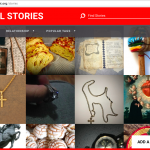Objects are central to museum interpretation, but seldom considered in the college classroom. Methods such as close looking, handling objects, and rummaging can help professors to be what Elizabeth Latham calls “object advocates” who “not only reveal many more layers of information, but will also provide opportunities…to project their own experiences onto objects,” and thereby connect with students at the material, personal, and socio-cultural levels.
Classroom Applications
Close Looking is a method that often applies visual thinking strategies to ask students to carefully observe one particular image or artifact for a given period.
Handling objects are passed around in class and offer many of the benefits of multi-sensory learning, including opportunities to identify and share cultural beliefs, ideas, and emotional responses.
Rummaging invites participants to “browse omnivorously” through a variety of objects or images.
Further Reading
- Chatterjee, Dr Helen J., and Dr Leonie Hannan, Engaging the Senses: Object-Based Learning in Higher Education. Ashgate Publishing, Ltd., 2015.
- Milkova, Liliana, and Steve Volk, “Crossing the Street; Pedagogy: Using College Art Museums to Leverage Significant Learning Across the Campus.” In A Handbook for Academic Museums: Exhibitions and Education, edited by Jandl Stefanie S. and Mark S. Gold, 88–118. Edinburgh, UK and Cambridge, MA: MuseumsEtc, 2012. https://www.academia.edu/10963073/Crossing_the_Street_Pedagogy_Using_College_Art_Museums_to_Leverage_Significant_Learning_Across_the_Campus.
- Wood, Elizabeth, and Kiersten F. Latham, The Objects of Experience: Transforming Visitor-Object Encounters in Museums. Walnut Creek, CA: Left Coast Press, 2013.
- Woodall, Alexandria, “Rummaging as a Strategy for Creative Thinking and Imaginitive Engagement in Higher Education” in Helen J. Chatterjee and Leonie Hannan, Engaging the Senses: Object-Based Learning in Higher Education (New York: Routledge, 2016)


